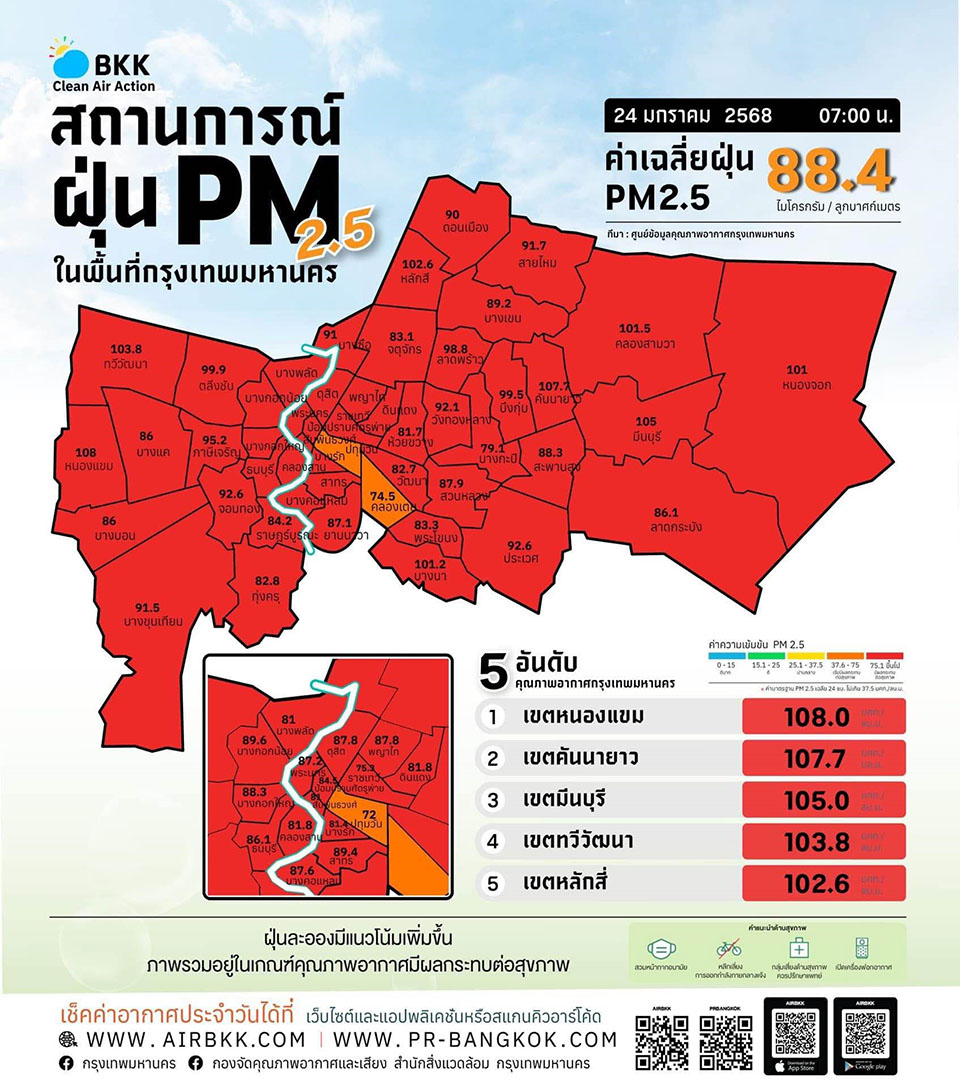
BANGKOK, Thailand – Bangkok’s air quality has hit critical levels as PM 2.5 particulate matter surged into the red zone, posing significant health risks. The crisis affects 67 areas in the city, with levels far exceeding safety standards. Authorities warn that the poor air quality is likely to persist until at least February 1.
Key PM 2.5 Measurements:
The Bangkok Air Quality Information Center reported PM 2.5 concentrations measured between 68.7 and 109.6 µg/m³ as of 7:00 AM on January 24. The safety threshold is 75.1 µg/m³, and areas classified in the red zone (unhealthy for all groups) include:
Nong Khaem District: Maja-aree Road (109.6 µg/m³)
Thawi Watthana District: Entrance to Sanam Luang 2 (109.1 µg/m³)
Khan Na Yao District: Intersection of Siam Park and Ram Inthra Road (108.5 µg/m³)
Prawet District: Seacon Square Shopping Mall (107.1 µg/m³)
Min Buri District: Opposite Min Buri District Office (104.9 µg/m³)
Lak Si District: Inside Lak Si District Office (104.7 µg/m³)
Bueng Kum District: Inside Bueng Kum District Office (104.0 µg/m³)
Bang Na District: In front of Big C Bang Na (103.8 µg/m³)
Khlong Sam Wa District: Inside Khlong Sam Wa District Office (101.8 µg/m³)
Taling Chan District: Intersection of Phutthamonthon Sai 1 and Borommaratchachonnani Road (100.3 µg/m³).
Causes of the Crisis:
The deterioration in air quality is attributed to several factors:
Weak ventilation: Air dispersal has been classified as “poor.”
Surface inversion: This atmospheric phenomenon traps pollutants near the ground, preventing dispersion.
The conditions are expected to remain critical between January 24-26, with only slight improvement anticipated. By January 27-28, ventilation may temporarily improve, leading to better dispersal of pollutants, before PM 2.5 levels are expected to rise again.
Public Health Concerns:
The elevated levels of PM 2.5 are hazardous to all population groups, particularly vulnerable individuals such as children, the elderly, and those with pre-existing respiratory or heart conditions. The fine particulate matter (less than 2.5 microns in diameter) can penetrate deep into the lungs and bloodstream, causing a range of health issues, including respiratory distress and cardiovascular problems.
Recommendations for Residents:
Authorities advise residents to take the following precautions:
Limit outdoor activities, especially in highly affected areas.
Wear high-efficiency masks, such as N95 respirators, when outdoors.
Use air purifiers indoors to reduce indoor pollution levels.
Monitor air quality updates and follow government advisories.
Moving Forward:
The Bangkok Metropolitan Administration (BMA) is coordinating with relevant agencies to address the situation and mitigate impacts. Long-term strategies, such as reducing vehicle emissions and controlling industrial pollution, remain critical to addressing recurring air quality challenges.
The public is urged to stay informed and prioritize health precautions as the city continues to grapple with this severe air quality crisis. (TNA)










